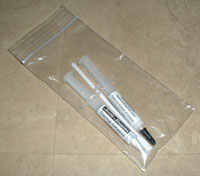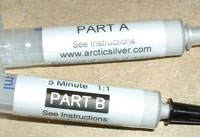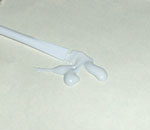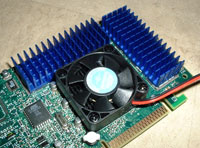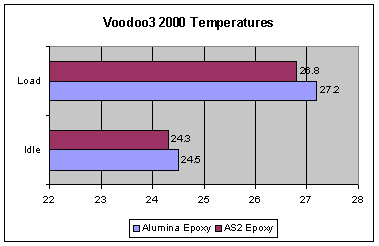|
Arctic Alumina Epoxy Review Date: December 25, 2001 |
| Provider: Arctic Silver |
| Manufacturer: Arctic Silver |
| Author: Mikhail Ivanenkov |
|
Before I begin I'd like to thank Nevin from Arctic Silver for sending over the Alumina compound & epoxy. In the world of thermal compounds and adhesives it's pretty easy to get trapped into buying a low-quality product. A while back we took a peek at Arctic Silver II Epoxy and were pretty impressed. I'm going to be very straight forward in this article with no in-depth explanations because in doing so I would confuse the reader and myself as well; if you want to know why a thermal epoxy is more effective than glue, read this. The initial problem with AS2e was the slight conductivity. While it is for the most part an idle substance, the bits of silver do have certain capacitive properties that, when adhered to electrical traces, can cause the device to short out. This was first noticed in video cards. Once people started gluing on ramsinks certain graphics adapters died for no apparent reason. Then they noticed that some of the compound oozed out over the metal traces connecting the memory modules to the PCB. Not good. The most common solution was to put masking tape around the chip so none of the compound would get to the vulnerable areas, but how do you know that you have a thin-enough layer which won't spread out once pressure is applied? You don't. Although "casualties" were reduced by this method, the uneasiness remained. And then Artic Silver introduced their Alumina compound, a suspension fluid of advanced polysynthetic oils that contained no silicone. The epoxy is similar to the compound and uses a layered composite of aluminum oxide (commonly known as alumina) and boron nitride. Still present are the three stages. First the compound starts out as a relatively thin mixture which dries within minutes of application. During the first hours of use the compound thins out even more to fill in any microscopic air gaps. Finally it thickens to its final consistency for optimal conductivity. Much like AS2e the Alumina came in a pair of syringes with 2.5g of each part for a total 5g of adhesive. Although lighter, you still get the same amount by volume which is actually going to yield slightly more applications because of the Alumina's relatively low consistency. Running for about $9 this is a very competitive solution to AS2e and is quickly replacing it for several reasons, namely price and its non-conductive nature. Part A is somewhat thinner than B and has no odor which would lead me to believe that it's the thermal portion of the compound. Part B is thicker and has a very strong and horrid smell, this is probably the glue. Out of the tube they look identical except for their respective consistencies. Mixing is a pretty simple task (more complex instructions/explanation can be found here); the provided "spatula" is good enough for blending and application. Once mixed, you have about 5 minutes to spread it before the compound starts to thicken. That's more than enough time so don't rush, the last thing you want is epoxy all over the place and a crappy bonding. Alumina epoxy is NOT meant for a CPU (for obvious reasons), so if that's what you're looking for you're better off with the thermal compound version. If you don't want a completely permanent bond you can add some Alumina (non-adhesive) to the mixture. This will still provide good conductivity yet at the same time allow you to remove it at some point in the future. One more thing: the caps are color coded, so please put them on the matching syringe, else you might find your tubes and caps bonded to each other. Also, there's really no way to tell if you mixed it in a 1:1 ratio, but as long as the two amounts appear similar it's ok. Fine point precision isn't really necessary. After applying the epoxy you need to give it time to settle and dry; 30 minutes seems to be a good cut-off point. For comparison I bonded one of the above ramsinks using AS2e and the other using Alumina to my Voodoo3 2000 AGP. In theory the temperatures should be pretty close. Here's the test system:
And the results:
As you can see the difference is very minor. AS2e still comes out on top by a tad bit, but 0.2C on idle and 0.4C on load is nothing to fret about. This may also be due to the fact that the Alumina epoxy may require up to 100 hours to reach the 3rd phase (like the compound) which was not the case during testing time. All in all they're pretty much identical. Here's a quick summary: Pros
Cons
So is it worth it? Yes. It's cheaper, works just as well, and gives you peace of mind that you won't kill a $150 video card (or anything else for that matter) because a little oozed out into the wrong spot. The package is generous; you get more than enough for a ton of applications. Just be careful when working with it and remember you have about 5 minutes to get things done. I'd like to thank Nevin from Arctic Silver once again for sending over the Alumina compound & epoxy. They don't sell the compound directly but many of our sponsors have these tubes in stock. If you have any questions or comments let me know here or post in the forums or both. Thanks for reading and enjoy the site! |
